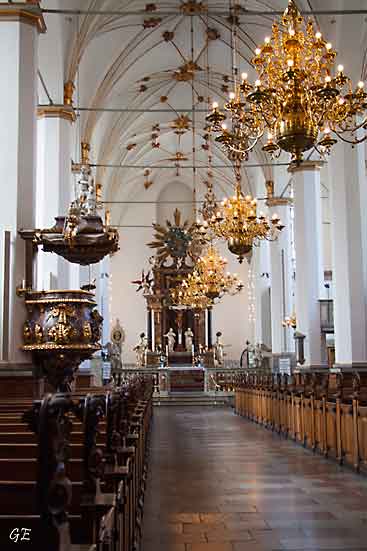En fin dag for en båttur med DFDS til København.
I København skulle vi bli 2 netter på hotell Opera,
så båten tilbake til Oslo
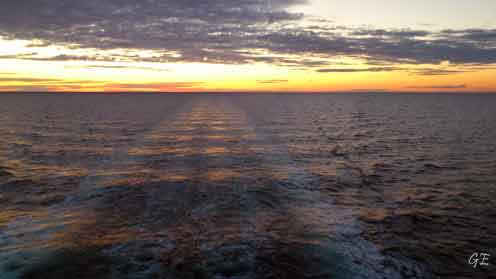
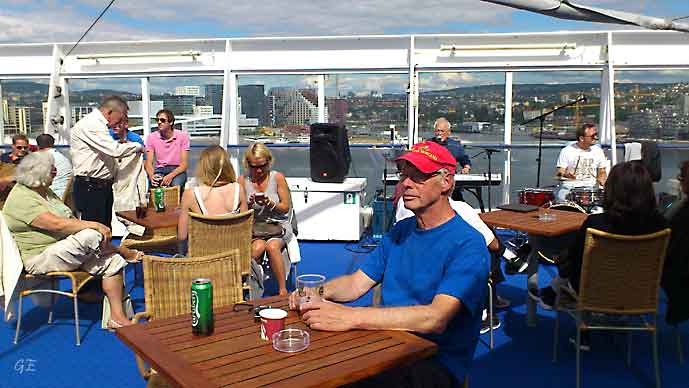
Fint på dekk på sånne sommerdager.
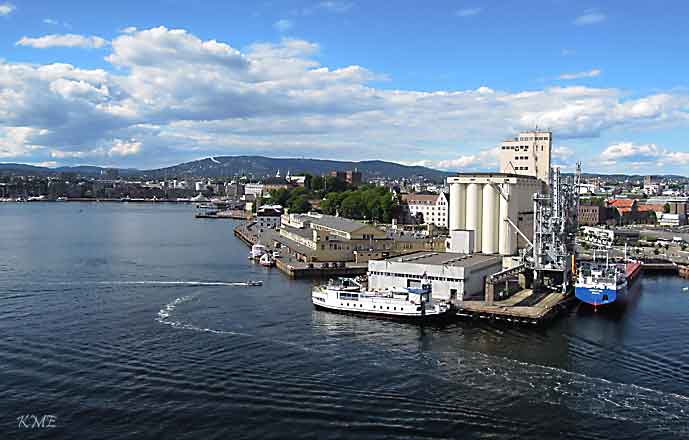
Farvel Oslo
| Onsdag
25. juni 2014 Framme i København. Herfra var det buss inn til sentrum. Bussen gikk til Kongens Nytorv og hotell Opera som vi skulle bo på, lå like ved. Et helt greit hotell med veldig sentral beliggenhet. Vi satte fra oss bagasjen på hotellet, og gikk forå se København. |
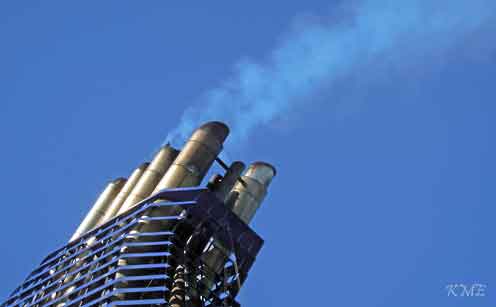 |
| Bildet:
Innseilingen til København. |
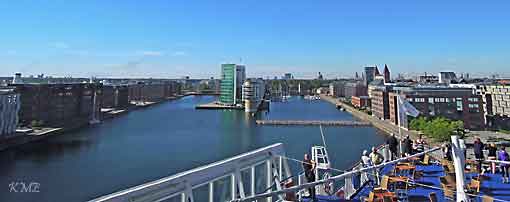 |
populous city of Denmark. As of July 2018, the city has a population of 777,218 (616,098 in
Copenhagen Municipality, 103,914 in Frederiksberg Municipality, 43,005 in Tårnby Municipality,
and 14,201 in Dragør Municipality).[3][7][8] It forms the core of the wider urban area of Copenhagen
(population 1,320,629) and the Copenhagen metropolitan area (population 2,057,737).
Copenhagen is situated on the eastern coast of the island of Zealand; another small portion of the city
is located on Amager, and it is separated from Malmö, Sweden, by the strait of Øresund.
The Øresund Bridge connects the two cities by rail and road.
Originally a Viking fishing village established in the 10th century in the vicinity of what
is now Gammel Strand, Copenhagen became the capital of Denmark in the early 15th century.
institutions, defences and armed forces. After a plague outbreak and fire in the 18th century, the
city underwent a period of redevelopment. This included construction of the prestigious district
of Frederiksstaden and founding of such cultural institutions as the Royal Theatre and the Royal
Academy of Fine Arts. After further disasters in the early 19th century when Horatio Nelson
attacked the Dano-Norwegian fleet and bombarded the city, rebuilding during the Danish
Golden Age brought a Neoclassical look to Copenhagen's architecture. Later, following the
Second World War, the Finger Plan fostered the development of housing and businesses along
the five urban railway routes stretching out from the city centre.
https://en.wikipedia.org/wiki/Copenhagen (16.9.2019)
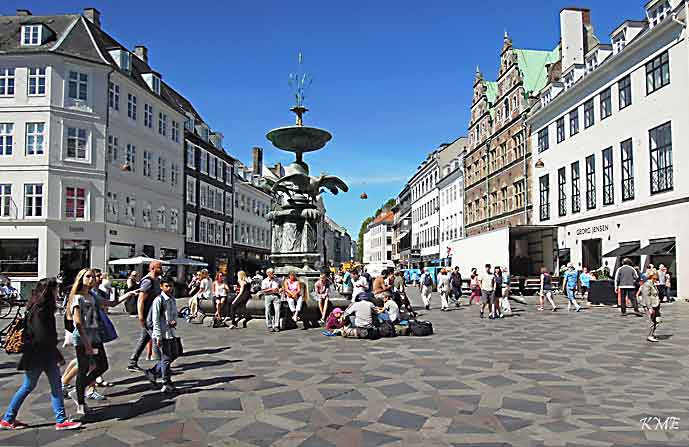
Først en liten tur innom Strøget.
Copenhagen's largest shopping area is centered around Strøget in the heart of the city. Strøget is one
of Europe's longest pedestrian streets with a wealth of shops, from budget-friendly chains to some of
the world's most expensive brands. The stretch is 1.1 kilometers long and runs from City Hall Square (Rådhuspladsen) to Kongens Nytorv.
Strøget is a nickname from the 1800s and covers the streets Frederiksberggade, Nygade,
Vimmelskaftet and Østergade and Nytorv square, Gammeltorv Square and Amagertorv Square.
(24. mars 2020) https://www.visitcopenhagen.com/copenhagen/planning/stroget-gdk414471
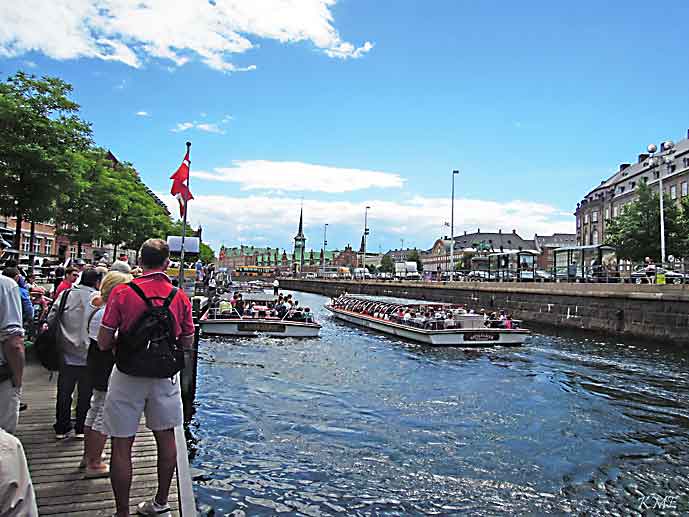
Så skulle vi til Christiansborg slott.
Men like ved Christiansborg legger kanalbåtene til.
Det var flott vær for en båttur, så vi gikk ombord.
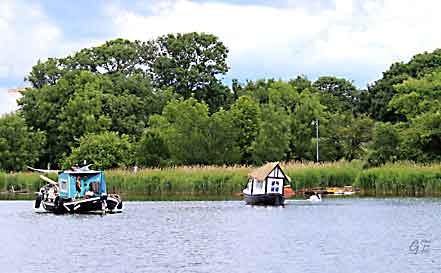 Husbåter |
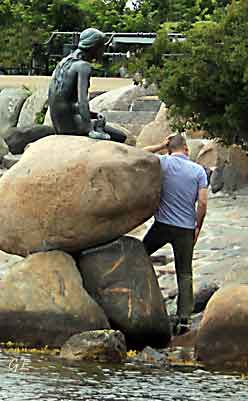 Den lille havfrue (Little Mermaid) |
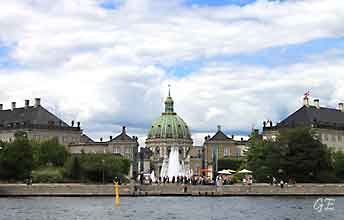 Amalienborg og Marmorkirken sett fra kanalbåten. Vi så nærmere på disse stedene senere på turen. |
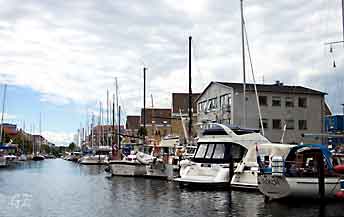 En av kanalene i byen |
At Langelinje Pier you will find one of Copenhagen's most famous tourist attractions: The sculpture
of The Little Mermaid. 23 August 2013 she turned 100 years old.Unveiled on 23 August 1913,
The Little Mermaid was a gift from Danish brewer Carl Jacobsen to the City of Copenhagen.
The sculpture is made of bronze and granite and was inspired by Hans Christian Andersen’s fairy tale about a mermaid who gives up everything to be united with a young, handsome prince on land.
https://www.visitcopenhagen.com/copenhagen/little-mermaid-gdk586951 (16.9.2019)
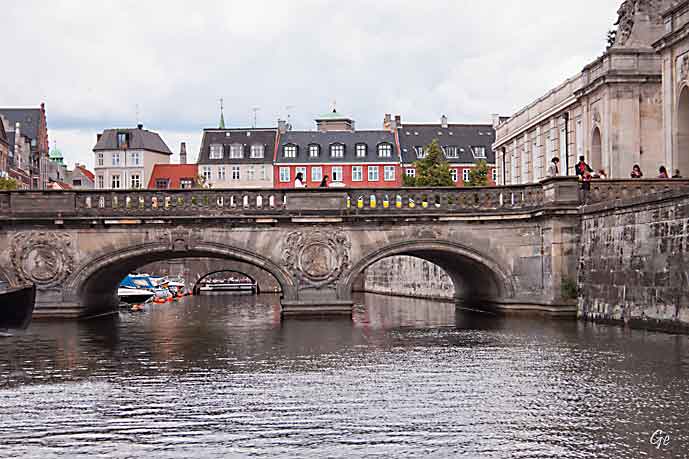
Turen gikk under mange lave broer.
Etter disse 2 broene var det i tillegg en
90 graders sving.
En utfordring med de lange kanalbåtene.
Det var en fin tur med en flink guide.
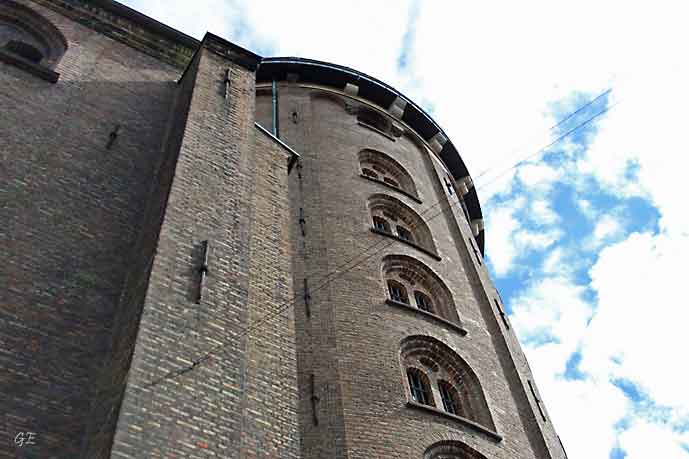
Etter kanalturen gikk vi til Runde Tårn.
The Round Tower is one of the most Denmark’s best-known and most visited edifices.
The foundation stone was laid on 7/7 1637 and five years later the Round Tower was finished as the
first part of the Trinity Complex, which was designed to accommodate three things: the Observatory
at the top of the tower, the University Library above the Trinity Church and the church itself below.
The Round Tower is built by King Christian IV, who constructed its round walls in the royal colours
yellow and red. The King himself also sketched the famous golden rebus on the front of the tower:
Lead, God, the right teachings and justice into the heart of King Christian IV.
https://www.rundetaarn.dk/en/intro/around-the-tower/ (16.9.2019)
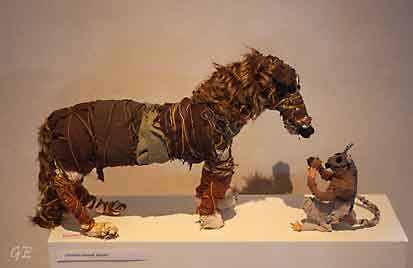 Christine Gunvor Jensen |
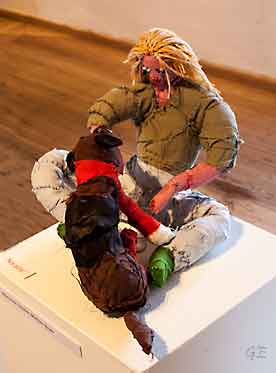 Marianne Quebec Madsen Ibsen |
| Utstilling
i Biblioteksalen i det Runde Tårn 21. juni – 17. august 2014 Kunstskolen for voksne udviklingshæmmede præsenter udstillingen: – Connect – Outsider Art |
 Fin kran i det Runde Tårn |
interior was heavily damaged during the great fire of 1728, and the present construction goes back to the rebuilding in 1731. (16.9.2019) https://www.visitcopenhagen.com/copenhagen/trinitatis-church-gdk410635 |
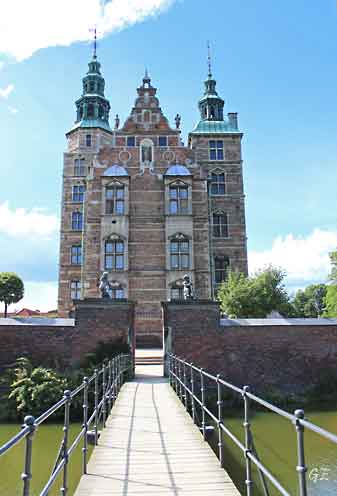 |
Fra
Runde Tårn gikk vi til slottet Rosenborg. A royal hermitage set in the King’s Garden in the heart of Copenhagen, Rosenborg Castle features 400 years of splendor, royal art treasures and the Crown Jewels and Royal Regalia. Rosenborg Castle was built by one of the most famous Scandinavian kings, Christian IV, in the early 17th century. Among the main attractions is the Knights’ Hall with the coronation thrones and three life-size silver lions standing guard. Tapestries on the walls commemorate battles between Denmark and Sweden. The interiors are well-preserved and invite you to take a journey in time. |
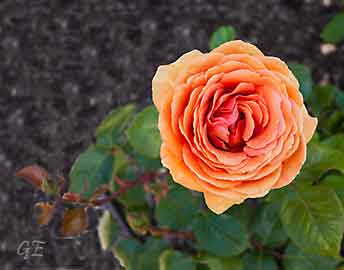 Rose: Ashram This strong growing Hybrid Tea of bright olde gold colouring flowers freely throughout the season. Shining dark green foliage has excellent resistance to blackspot and mildew. The large, full blooms are suitable for picking. Slight fragrance. 1.2m tall. http://www.treloarroses.com.au/index.php? route=product/product&product_id=2208 |
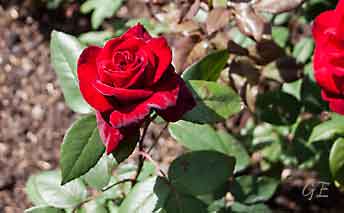 Barkarole ? (1988) Er du til klassiske røde roser? Så er Barkarole rosen lige hvad du søger! Rosen får de flotteste store dybmørkerøde blomster fra juni-september og egner sig godt til haver og parker. https://www.jespersplanteskole.dk/ storblomstrende-rose-barkarole (16.9.2019) |
royal inhabitants.Rosenborg also houses an exquisite collection of Flora Danica and one of the
world’s finest Venetian glass collections, both set in tower chambers.
See Denmark's crown jewels
The crowns of the Danish kings and queens are kept in special vaults and are embellished with table-cut stones, enamel and gold ornamentation.The crown jewels primarily consist of four garnitures: a diamond set, a ruby
set, a pearl set, and an emerald set – the emeralds being among the world’s finest.
Rosenborg Castle has a sister museum at Amalienborg Palace displaying royal history
from the mid 19th century unto today.Portraits of Caroline Mathilde and Struensee. (24. mars 2020)
https://www.visitcopenhagen.com/copenhagen/planning/rosenborg-castle-gdk410582
Da vi skulle kjøpe inngangsbilletter var klokka kvart over 4.
Slottet stengte klokka 5.
Så vi ble anbefalt å komme igjen en annen dag.
Tre kvarter var alt for lite mente billettselgeren, og det var vel riktig.

Nyhavn
Middag spiste vi i Nyhavn.
Especially during summer, Nyhavn is the perfect place to end a long day.
With a cold one on the quay like the locals, or at one of the many restaurants.
Originally, Nyhavn was a busy commercial port where ships from all over the
world would dock.
The area was packed with sailors, ladies of pleasure, pubs and alehouses.
Today the beautiful old houses have been renovated and restaurants dominate
the old port. Nyhavn is filled with people enjoying the relaxed atmosphere by
the canal, jazz music and great food.
https://www.visitcopenhagen.com/copenhagen/nyhavn-gdk474735 (16.9.2019)
Dagens plan:
1 Vår Frelser kirke, opp i tårnet
2. Amalienborg slott
3. Marmorkirken
4. Uranienborg slott
 Jeg likte dette gatenavnet. På den andre siden av kanalen het det: Overgaden neden Vandet When Christian IV planned Christianshavn in 1617, it was intended as an independent merchant's town on the island of Amager and it therefore needed a church. A temporary church was inaugurated in 1639 but construction of the present Church of Our Saviour, the design of Lambert van Haven, did not start until 1682. The church was inaugurated 14 years later in 1695 but important interior features like the altar had a notoriously temporary character and the tower still had no spire. The church got its permanent altar in 1732 but plans for construction of the spire was not revitalized until 1747 under the reign of Frederik V. |
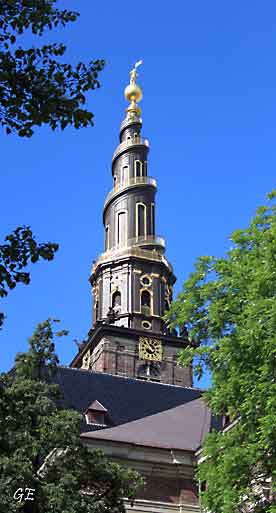 |
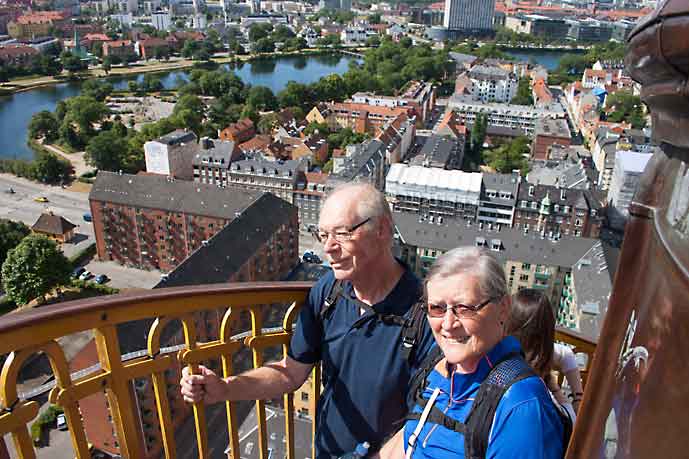
Vår Frelser kirke
The new architect on the project was Lauritz de Thurah.
He soon abandoned van Haven's original design in favour of his own project that was
approved by the King in 1749. Three years later the spire was finished and the King climbed
the tower at a ceremony on 28 August 1752.
Urban legend
There is a long-lived urban legend stating that the architect killed himself by jumping from the
top of the spire, when he realised that the spiral turns the wrong way - anticlockwise - around.
This is not about Lambert van Haven, since the spire was added to the church almost 50 years
after his death, but the designer of the spiral spire, Laurids de Thurah.
There is no truth in the myth though, since Thurah died in his bed seven years after the spire was completed, and there is nothing in the records that indicates that he should have been unhappy with
his work in any way. (24. mars 2020)
https://en.wikipedia.org/wiki/Church_of_Our_Saviour,_Copenhagen

Utsikten fra tårnet er fin.
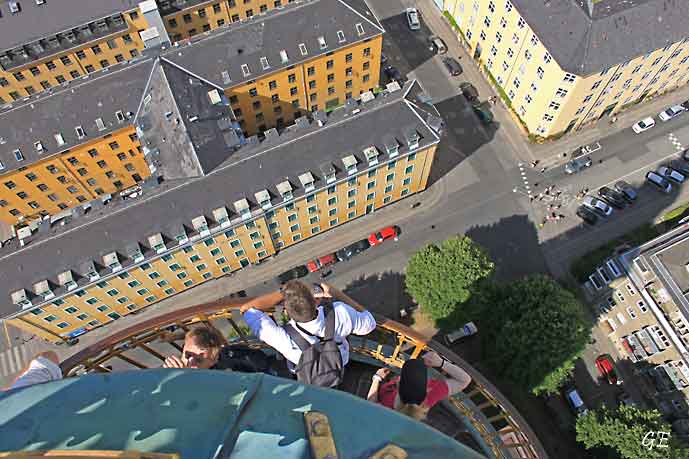
Det er langt ned.
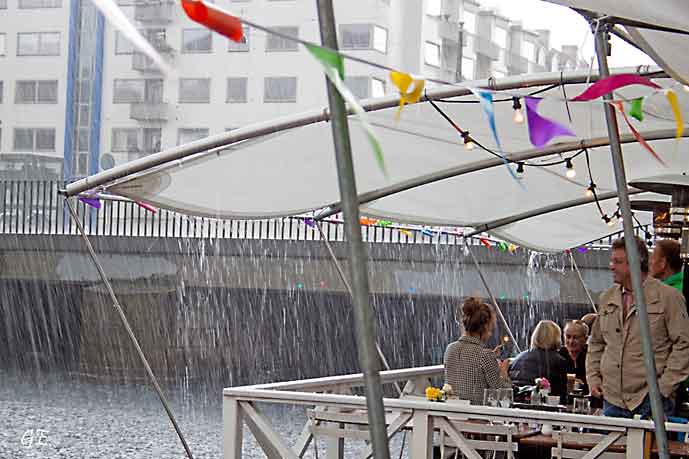
Vi trengte en hvil etter alle trappetrinna.
Like ved kirken ligger er koselig sted som heter River. Vi tok en øl hver, og et wienerbrød.
Vi var akkurat ferdige, og skulle gå videre da uværet kom. Regn, hagl, lyn og torden.
Godt vi var kommet ned fra kirketårnet.
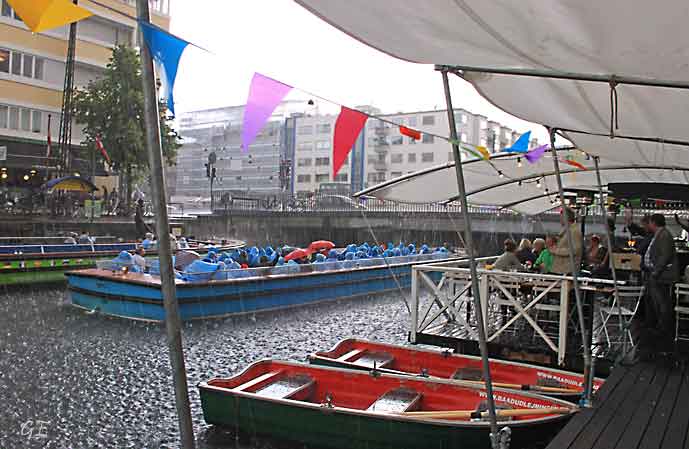
Trivelig tur med kanalbåten.
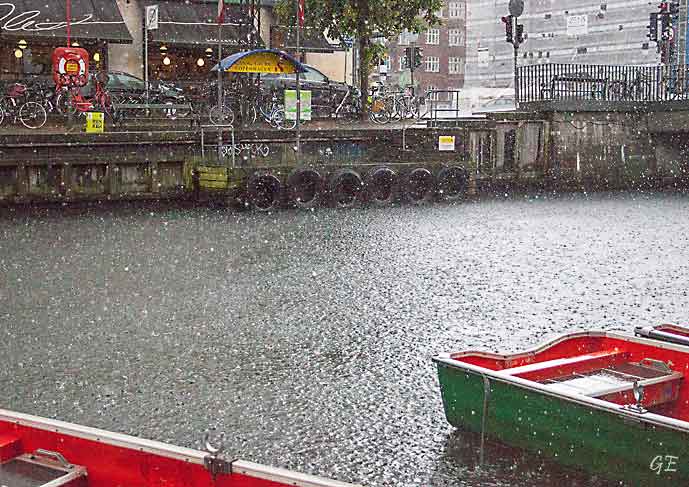
Uværet varte ganske lenge.
Vi ble på River til det var over, tok en varm kakao med krem.
Selv om det hadde sluttet å regne da vi gikk fra River, ble vi fort våte.
Derfor gikk vi innom hotelletfor å skifte bukse og sokker. Så fortsatte rundturen vår
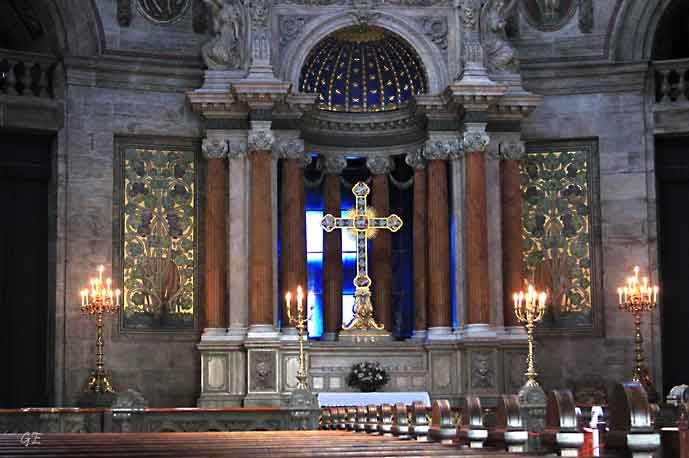
Marmorkirken ved Amalienborg
Frederiks Kirke (Marmorkirken)
The awe-inspiring Marble Church with the characteristic copper green dome has to be one of the
most impressive churches of the city - and is definitely home to one of the best views in town.
The church lies beautifully in line with Amalienborg castle and The Opera in the middle of the
elegant area of Frederiksstaden. In fact the official name of the church is Frederik's Church.
The Marble Church has an interesting story. Presided by King Frederik V the foundation stone was
laid in 1749 as part of a grand plan of making a new city district called Frederiksstaden.
A capsized project
The architect Nicolai Eigtved died in 1754 and the French architect Jardin continued the building
after a revised drawing.
The work now proceeded at snail's pace and owing to a squeeze in the funding the completion of
the building was postponed several times.
The building was not resumed until late 1800's for the church to be finallyinaugurated in 1894.
Today the church seeks to be a modern city church and thus the church room is open to the public
every day.
There is a magnificent view from the dome, which can be visited at 1 pm every day during the
summer months and the same hours in the weekends of the rest of the year. (24. mars 2020)
https://www.visitcopenhagen.com/copenhagen/planning/marble-church-gdk414142
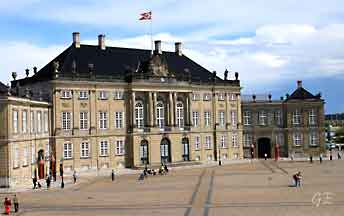 Amalienborg. Kronprinsens residens sett fraAmalienborgmuseet. Amalienborg-palæerne Amalienborg is HM The Queen's winter residence. The Amalienborg complex consists of four palaces, built around an octagonal courtyard, in the centre of which stands the French sculptor J.F.J. Saly’s equestrian statue of Frederik V, the founder of Amalienborg and Frederiksstaden. The complex was constructed by Frederik V on the occasion of the 300th anniversary of the coronation of Christian I, the first King of the House of Oldenborg. The site for the four palaces was given to four prominent noblemen, A.G. Moltke, Christian Frederik Levetzau, Joachim Brockdorf and Severin Løvenskiold, who committed themselves to building identical palaces, designed by the court architect Nicolai Eigtved. Amalienborg became the royal residence after Christiansborg Palace burned down in the night between 26 and 27 February 1794. In the course of a few days, the king acquired both the Moltke and Schack Palaces. Amalienborg (kongehuset.dk) (18. mars 2023) |
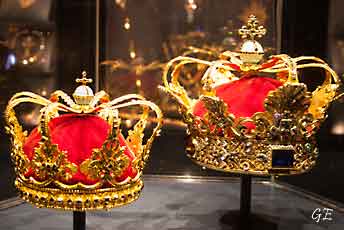 Konge og dronningkrone i skattkammeret på Rosenborg. Dronningkrone fra 1648. Dronningens krone, (venstre) Sophia Magdalen of Brandenburg-Kulmbach, the queen of king Christian VI, did not want to use the crown worn by her predecessor and had a new crown made by royal jeweler Frederik Fabritius (1683-1755) in 1731. This crown is made like that of Christian V but only taller and more slender. It is decorated with table cut diamonds that are assumed to come from the 1648 crown of Queen Sophie Amalie. (24. mars 2020) https://en.wikipedia.org/wiki/Danish_Crown_ Regalia#The_queen's_crown Krone til høyre: Christian 5.s krone This crown is the official crown that was used for the anointments of Danish absolute monarchs until the end of absolutism in 1849. The first Danish absolute monarch Frederick III wanted his son and heir-apparent, the later Christian V, to be in possession of the visible symbols of power at the moment he himself died and his son inherited the title. Therefore, he secretly commissioned several crown regalia, including a crown, to surround the anointing of the absolute monarchs with as much glory as possible.The crown was first used for the coronation of Christian V and the last time for the coronation of Christian VIII in 1840. Today the crown is used as a symbol of the monarchy and the state. Its only ceremonial use is when it is placed on the Castrum doloris of a deceased monarch. (24. mars 2020) https://en.wikipedia.org/wiki/Danish_Crown_Regalia |
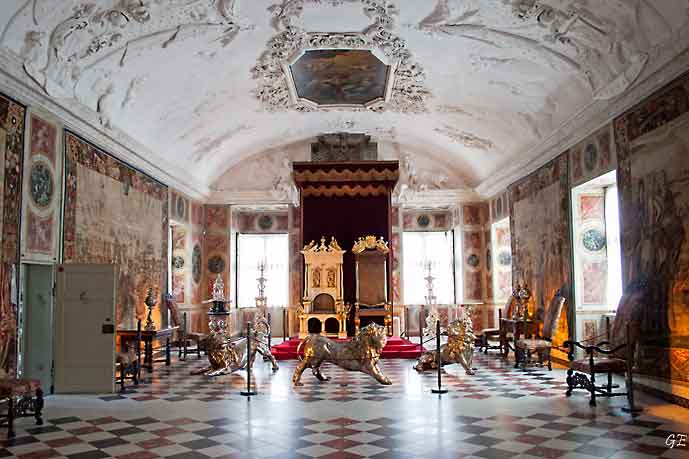
Fra Amalienborg gikk vi videre til Rosenborg Slott.
Denne gang var vi i både skattkammeret og selve slottet.
Fredag 27. juni 2014
Siste dag i København for denne gang. Vi gikk en tur på Strøget.
Shoppingen begrenset seg til engenser.
En tur på konditori ble det også.
Danmarksturen ble avsluttet med lunsj på Højbro Plads.
På båten ble det fin middag på Marco Polo.
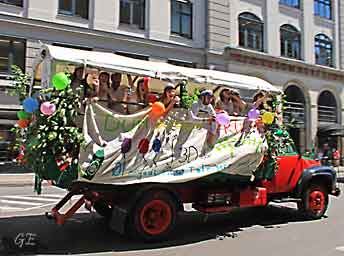 Dansk "russefeiring" |
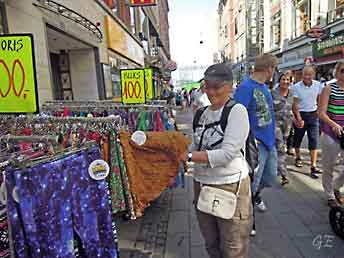 Shopping på Strøget. |
Grete
